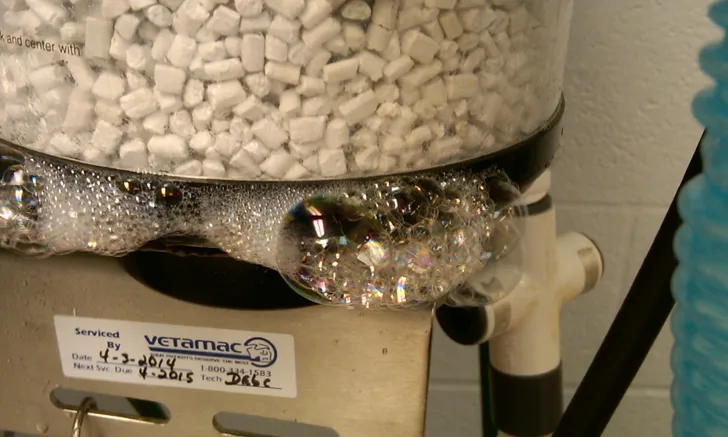Anesthesia Machines: Finding Leaks

Benjamin Franklin famously said, “An ounce of prevention is worth a pound of cure”—to address fire safety.1 When a canine or feline patient is waking up during surgery, many reasons (eg, empty vaporizer, hole in the endotracheal tube cuff, hole in the rebreathing bag, cracked sodalime canister) will come to mind and the veterinary technician may feel like he or she is putting out a fire.
Pressure testing the anesthesia machine prior to surgery is “an ounce of prevention.”
The pressure test can help prevent contaminating the team and the environment with anesthetic gases from machine leaks and prevent costly loss of oxygen because of worn gaskets on the E tank yoke. Testing also eliminates the possibility of the patient waking up during the surgery due to a problem with the anesthesia machine.
Conducting a Pressure Test
Perform a pressure test for a rebreathing system as follows:
Connect the appropriate circuit and rebreathing bag to the anesthesia machine.
Close the pop-off valve.
Occlude the y-piece end.
Pressurize the circuit with the flush valve and/or flowmeter to approximately 30 cmH2O.2
Turn the flow completely off when the pressure reaches 30 cmH2O and see whether the manometer rises or falls.
If the pressure falls but holds with the flowmeter set at 300ml/min or less, then the leak is acceptable, according to FDA standards.3
If the leak requires a fresh gas flow rate >300ml/min to hold pressure, locate and correct the leak prior to use.4
If the pressure continues to rise when the flow is completely off, the leak can be either the flowmeter or the flush valve. If the flush valve is leaking the inhalant anesthetic will be diluted, making it difficult to keep patients anesthetized. If the flowmeter is leaking, the flow will continue and the float will not rest on the bottom of the tube even though the knob is turned off completely. A service technician can determine the source of leak by using a handheld manometer. Always release the pressure by opening the pop-off valve.
If holding the pressure at 30 cmH2O requires more than 300 ml/min, locate and correct the leak, which can usually be found by spraying the machine with a soapy solution and watching for bubbles.
Finding the Leak
The following scenarios highlight machine areas that should be investigated to pinpoint a leak.
Scenario 1: The flush valve is used to fill the bag during a pressure test, but the manometer will not rise above 5 cmH2O and falls to zero when the valve is released.
Solution: Ensure the pop-off valve is closed. If so, a leak of this magnitude is typically associated with the gaskets on the sodalime canister. (See Figure 1.) When changing the sodalime, clean the canister and gaskets to ensure a proper seal. (See Figures 2 & 3.) Check the canister’s alignment on the machine.4 Check the pop-off valve by disconnecting the scavenger tubing and plugging the pop-off outlet. The pop-off can leak because of moisture and a buildup of sodalime dust and will not close completely.
Scenario 2: The pressure test reveals a 500 ml/min leak.
Solution: Rule out cracks in the sodalime canister, malfunctions with the pop-off valve, pin holes in the rebreathing bag, and cracks and holes in the breathing circuit. Next, check the inspiratory and expiratory domes for cracks and proper alignment. (See Figure 4.) Domes are sealed by O-rings or gaskets; exposed O-rings break down more quickly than those sealed within the machine, whereas gaskets may last longer but eventually become hardened and need to be replaced. Inspect threaded domes for cracks or wear. Replace damaged domes.

FIGURE 1
Leakage from the lower sodalime canister gasket because of granules.
Photos courtesy of Debbie Coleman, RVT, VTS (Anesthesia)
Other Leak Sources
The vaporizer is another potential source of leaks. Check the external components by lightly spraying the inlet and outlet end caps and the funnel fill cap with soap solution. Inspect leaking end caps for dents, clean them, and replace on the vaporizer as tightly as possible. Inspect the funnel and the O-ring on the cap of a funnel fill. Both areas can be cleaned with a gauze sponge lightly moistened with alcohol. (See Figure 5.) Use the notch on the cap top to ensure the pin is tight. (Figures 6 & 7.)
Conclusion
Daily maintenance and proper cleaning of the anesthesia machine will prevent leaks and ensure patient and veterinary team safety.